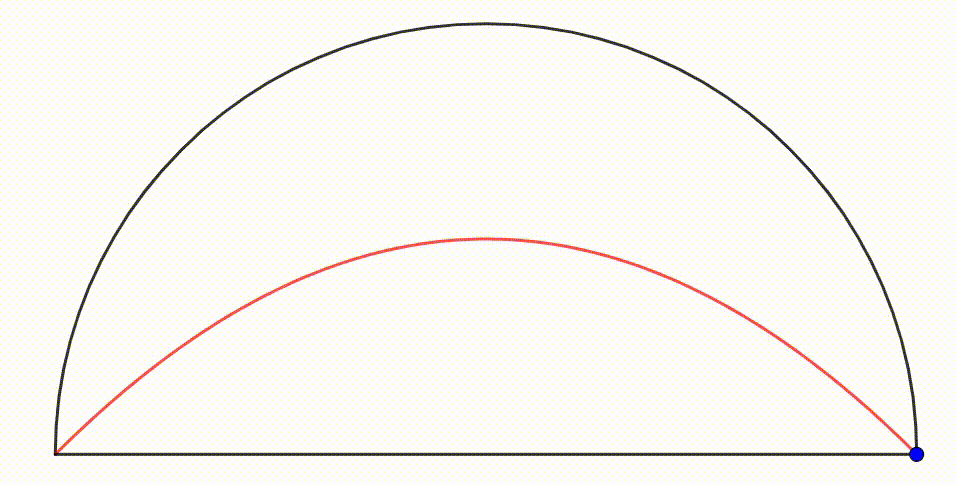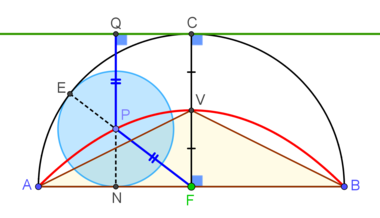Dynamic Geometry: P22

The diagram shows a semicircle with radius 1 . The cyan circle is any circle which is tangent to the arc and diameter of the semicircle internally. The centers of all such cyan circle trace a locus (red curve).
The area bounded by the red curve and the diameter of semicircle can be expressed as b a , where a and b are coprime positive integers. Find a + b .
The answer is 5.
This section requires Javascript.
You are seeing this because something didn't load right. We suggest you, (a) try
refreshing the page, (b) enabling javascript if it is disabled on your browser and,
finally, (c)
loading the
non-javascript version of this page
. We're sorry about the hassle.
2 solutions
Thank you for posting !
Let’s see a purely geometric solution, not using coordinate geometry nor modern calculus, with the aid of Archimedes (although he uses the method of exhaustion, on which calculus is based).
Label the figure as follows, where the green tangent is parallel to the diameter of the semi-circle,
P
is the center of the circle,
F
is the center of the semi-circle,
E
and
C
are points of tangency and
Q
N
is perpendicular to
A
B
through
P
.
 First we prove that the locus of the circle is part of a parabola.
First we prove that the locus of the circle is part of a parabola.
Indeed,
P F = F E − P E = F C − P N = Q N − P N = P Q Thus, the red curve is a parabola where F is its focus, the green line is its directrix and the midpoint of F C , V , is its vertex. We are interested in the area of the parabolic segment bounded by the parabola and its chord A B .
Now, in his treatise The Quadrature of the Parabola , Archimedes proves that
The area of a parabolic segment is 3 4 that of the triangle whose base is the given chord of the parabola, and the third vertex is the point on the parabola such that the tangent to the parabola at that point is parallel to the chord.
In our case, this triangle is V A B , hence,
Area of parabolic segment = 3 4 [ V A B ] = 3 4 × 2 1 A B ⋅ F V = 3 4 × 2 1 × 2 × 2 1 = 3 2 For the answer, a = 2 , b = 3 , thus a + b = 5 .
Very interesting Thanos, thank you for taking the time to share your solution !
Let the center of the semicircle be the origin O ( 0 , 0 ) of the x y -plane and any point on the locus be P ( x , y ) . Then we note that y = r and
( 1 − r ) 2 − r 2 ( 1 − y ) 2 − y 2 − 2 y + 1 ⟹ y = x 2 = x 2 = x 2 = 2 1 − x 2 Since y = r
The equation of the locus is y = 2 1 − x 2 . [ U p d a t e d : ] As suggested by @Thanos Petropoulos , since f ( x ) = 2 1 − x 2 is a parabola, the area bounded by the locus and the diameter is two thirds the smallest rectangle inscribing the parabola. That is A = 3 2 × f ( 0 ) × 2 = 3 2 × 2 1 × 2 = 3 2 . Therefore a + b = 2 + 3 = 5 .